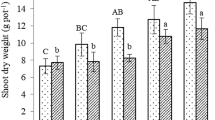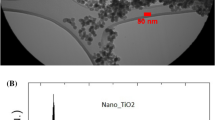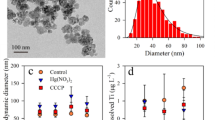Abstract
How the NPs effect the growth and physiological response like the release of organic acids along the root exudates is largely unknown yet. In this study, the effects of titanium dioxide (TiO2) and silicon dioxide (SiO2) nanoparticles (NPs) treatments (1000 mg/L) on maize seedlings for 6 days were examined. Plant biomass, pigment, malondialdehyde (MDA), reactive oxygen species (ROS) production, and contents of organic acids in root exudates were analyzed. SiO2 NPs significantly reduced (p < 0.05) shoot length, roots, and shoot fresh weight. TiO2 NPs showed significant differences (p < 0.05) in pigment contents compared to the CK. Chlorophyll a, b, total chlorophyll content, and chlorophyll/carotenoid ratio decreased by 27.8%, 29%, 28.1%, and 46.1%, respectively, while the content of carotenoid increased by 33.6% (p < 0.05). As concerns SiO2 NPs treatment, there was no significant increase (p > 0.05) in chlorophyll a content compared to the CK, while chlorophyll b increased by 28.9% (p < 0.05), and chlorophyll a/b ratio and content of carotenoid decreased by 16.8% and 54.7% (p < 0.05), respectively. MDA content significantly diminished in roots and leaves under SiO2 NPs. However, O2·ˉ production increased in roots by 17.2% and 23.8% (p < 0.05), respectively, under TiO2 and SiO2 NPs treatment. The pH of root exudates was declined by 17.4% and 14.2% (p < 0.05) respectively under both NPs treatment. Organic acid contents under TiO2 NPs significantly heightened (p < 0.05) by 60.7%, 31.2%, and 50.5% for citric, lactic, and fumaric acid, respectively, while formic and oxalic acid decreased by 27.8% and 26.4% respectively compared to the CK. In SiO2 NPs case, oxalic acid increased by 41.1% (p < 0.05), while malic and citric acid decreased by 62.6% and 45.7% respectively compared to the CK. In conclusion, both NPs treatments showed alternative impacts on maize seedlings.






Similar content being viewed by others
References
Koce, J. D., Drobne, D., Klancnik, K., Makovec, D., Novak, S., & Hocevar, M. (2014). Oxidative potential of ultraviolet—a irradiated or nonirradiated suspensions of titanium dioxide or silicon dioxide nanoparticles on Allium cepa roots. Environmental Toxicology & Chemistry, 33(4), 858–867. https://doi.org/10.1002/etc.2496.
Menard, A., Drobne, D., & Jemec, A. (2011). Ecotoxicity of nanosized TiO2: Review of in vivo data. Environmental Pollution, 159, 677–684. https://doi.org/10.1016/j.envpol.2010.11.027.
Passagne, I., Morille, M., Rousset, M., Pujalte, I., & L’azou, B. (2012). Implication of oxidative stress in size-dependent toxicity of silica nanoparticles in kidney cells. Toxicology, 299, 112–124. https://doi.org/10.1016/j.tox.2012.05.010.
Vittori, A. L., Carbone, S., Gatti, A., Vianello, G., & Nannipieri, P. (2014). Uptake and translocation of metals and nutrients in tomato grown in soil polluted with metal oxide (CeO2, Fe3O4, SnO2, TiO2) or metallic (Ag, Co, Ni) engineered nanoparticles. Environmental Science & Pollution., 22(3), 1841–1853. https://doi.org/10.1016/j.scitotenv.2019.05.265.
Jacob, D. L., Borchardt, J. D., Navaratnam, L., Otte, M. L., & Bezbaruah, A. N. (2015). Uptake and translocation of Ti from nanoparticles in crops and wetland plants. International Journal of Phytoremediation, 15(2), 142–153. https://doi.org/10.1080/15226514.2012.683209.
Servin, A. D., Morales, M. I., Castillo-Michel, H., Hernandez-Viezcas, J. A., Muniz, B., Zhao, L., Nunez, J. E., Peralta-Videa, J. R., & Gardea-Torresdey, J. L. (2013). Synchrotron verification of TiO2 accumulation in cucumber fruit: A possible pathway of TiO2 nanoparticle transfer from soil into the food chain. Environmental Science & Technology, 47, 11592–11598. https://doi.org/10.1021/es403368j.
Schmitt, F. J., Renger, G., Friedrich, T., Kreslavski, V. D., Zharmukhamedov, S. K., Los, D. A., Kuznetsov, V. V., & Allakhverdiev, S. I. (2014). Reactive oxygen species: Reevaluation of generation, monitoring and role in stress-signaling in phototropic organisms. Biochimica et Biophysica Acta, 1837, 835–848. https://doi.org/10.1016/j.bbabio.2014.02.005.
Yang, F., Hong, F., You, W., Liu, C., Gao, F., Wu, C., & Yang, P. (2006). Influences of nano-anatase TiO2 on the nitrogen metabolism of growing spinach. Biological Trace Elements Research, 110(2), 179–190. https://doi.org/10.1385/bter:110:2:179.
Mishra, V., Mishra, R. K., Dikshit, A., & Pandey, A.C. (2014). Interactions of nanoparticles with plants. Emerging technologies and management of crop stress tolerance. Oxford: Elsevier Inc, pp. 159–180. https://doi.org/10.1016/B978-0-12-800876-8.00008-4.
Suriyaprabha, R., Karunakaran, G., Yuvakkumar, R., Prabu, P., Rajendran, V., & Kannan, N. (2012). Growth and physiological responses of maize (Zea mays L.) to porous silica nanoparticles in soil. Journal of Nanoparticles Research, 14(12), 1–14. https://doi.org/10.1007/s11051-012-1294-6.
Siddiqui, M. H., & Al-Whaibi, M. H. (2014). Role of nano-SiO2 in germination of tomato (Lycopersicum esculentum Mill.). Saudi Journal of Bioliological Science, 21(1), 13–17. https://doi.org/10.1016/j.sjbs.2013.04.005.
Slomberg, D. L., & Schoenfisch, M. H. (2012). Silica nanoparticle phytotoxicity to Arabidopsis thaliana. Environmental Science & Technology, 46, 10247–10254. https://doi.org/10.1021/es300949f.
Monica, R. C., & Cremonini, R. (2009). Nanoparticles and higher plants. Caryologia, 62(2), 161–165. https://doi.org/10.1080/00087114.2004.10589681.
Zeng, F., Chen, S., Miao, Y., Wu, F., & Zhang, G. (2008). Changes of organic acid exudation and rhizosphere pH in rice plants under chromium stress. Environmental Pollution, 155(2), 284–289. https://doi.org/10.1016/j.envpol.2007.11.019.
Ding, Y. Z., Song, Z. G., Feng, R. W., & Guo, J. K. (2014). Interaction of organic acids and pH on multi-heavy metal extraction from alkaline and acid mine soils. International Journal of Environmental Science & Technology, 11, 33–42. https://doi.org/10.1007/s13762-013-0433-7.
Janicka-Russak, M., Kabala, K., Burzynski, M., & Klobus, G. (2008). Response of plasma membrane H+-ATPase to heavy metal stress in Cucumis sativus root. Journal of Experimental Botany, 59, 3721–3728. https://doi.org/10.1093/jxb/ern219.
Javed, M. T., Stoltz, E., Lindberg, S., & Greger, M. (2013). Changes in pH and organic acids in mucilage of Eriophorum angustifolium roots after exposure to elevated concentrations of toxic elements. Environmental Science Pollution Research, 20(3), 1876–1880. https://doi.org/10.1007/s11356-012-1413-z.
Huang, G., Guo, G., Yao, S., Zhang, N., & Hu, H. (2016). Organic acids, amino acids compositions in the root exudates and Cu-accumulation in castor (Ricinus communis L.) under Cu stress. International Journal of Phytoremediation, 18, 33–40. https://doi.org/10.1080/15226514.2015.1058333.
Xin, J. L., Huang, B. F., Dai, H. W., Zhou, W. J., Yi, Y. M., & Peng, L. J. (2014). Roles of rhizosphere and root-derived organic acids in Cd accumulation by two hot pepper cultivars. Environmental Science & Pollution Research, 22(8), 6254–6261. https://doi.org/10.1007/s11356-014-3854-z.
Xie, X., Weiss, D. J., Weng, B., Liu, J., Lu, H., & Yan, C. (2013). The short-term effect of cadmium on low molecular weight organic acid and amino acid exudation from mangrove (Kandelia obovata (S., L.) Yong) roots. Environmental Science & Pollution Research, 20, 997–1008. https://doi.org/10.1007/s11356-012-1031-9.
Zhi, A. L., Bi, Z., Han-Ping, X., Yong-Zhen, D., Wan-Neng, T., & Sheng-Lei, F. (2008). Role of low-molecule-weight organic acids and their salts in regulating soil pH. Pedosphere, 18(2), 137–148. https://doi.org/10.1016/S1002-0160(08)60001-6.
Zhang, R., Zhang, H., Tu, C., Hu, X., Li, L., Luo, Y., & Christie, P. (2015). Phytotoxicity of ZnO nanoparticles and the released Zn(II) ion to corn (Zea mays L.) and cucumber (Cucumis sativus L.) during germination. Environmental Science and Pollution Research, 22, 11109–11117. https://doi.org/10.1007/s11356-015-4325-x.
Lin, D., & Xing, B. (2007). Phytotoxicity of nanoparticles: Inhibition of seed germination and root growth. Environmental Pollution, 150, 243–250. https://doi.org/10.1016/j.envpol.2007.01.016.
Zhang, D., Hua, T., Xiao, F., Chen, C., Gersberg, R. M., Liu, Y., Stuckey, D., Wun Jern Ng, W. J., & Tan, S. K. (2015). Phytotoxicity and bioaccumulation of ZnO nanoparticles in Schoenoplectus tabernaemontani. Chemosphere, 120, 211–219. https://doi.org/10.1016/j.chemosphere.2014.06.041.
Hoagland, D. R., & Arnon, D. I. (1950). The water-culture method for growing plants without soil. California Agricultural Experimental Station Circular, 347, 357–359.
Wang, Z. Y., Xie, X. Y., Zhao, J., Liu, X. Y., Feng, W. Q., White, J. C., & Xing, B. S. (2012). Xylem- and phloem-based transport of CuO nanoparticles in maize (Zea mays L.). Environmental Science & Technology, 46, 4434–4441. https://doi.org/10.1021/es204212z.
Lin, D., & Xing, B. (2008). Root uptake and phytotoxicity of ZnO nanoparticles. Environmental Science & Technology, 42, 5580–5585. https://doi.org/10.1021/es800422x.
Li, J., Hu, J., Ma, C., Wang, Y., Wu, C., Huang, J., & Xing, B. (2016). Uptake, translocation and physiological effects of magnetic iron oxide (γ-Fe2O3) nanoparticles in corn (Zea mays L.). Chemosphere, 159, 326–334. https://doi.org/10.1016/j.chemosphere.2016.05.083.
Arnon, D. I. (1949). Copper enzymes in isolated chloroplasts—Polyphenoloxidase in Beta vulgaris. Plant Physiology, 24(1), 1–15. https://doi.org/10.1104/pp.24.1.1.
Chen, J., Wang, W. H., Wu, F. H., You, C. Y., Liu, T. W., Dong, X. J., He, J. X., & Zheng, H. L. (2013). Hydrogen sulfide alleviates aluminum toxicity in barley seedlings. Plant and Soil, 362, 301–318. https://doi.org/10.1007/s11104-012-1275-7.
Pan, X., Yang, J., Mu, S., & Zhang, D. (2012). Fluorescent properties and bifenthrin binding behavior of maize (Zea mays L.) seedling root exudates. European Journal of Soil Biology, 50, 106–108. https://doi.org/10.1016/j.ejsobi.2012.01.001.
Valentinuzzi, F., Cesco, S., Tomasi, N., & Mimmo, T. (2015). Influence of different trap solutions on the determination of root exudates in Lupinus albus L. Biology and Fertility of Soils, 51, 757–765. https://doi.org/10.1007/s00374-015-1015-2.
Zhang, N., Wang, D., Liu, Y., Li, S., Shen, Q., & Zhang, R. (2014). Effects of different plant root exudates and their organic acid components on chemotaxis, biofilm formation and colonization by beneficial rhizosphere-associated bacterial strains. Plant and Soil, 374, 689–700. https://doi.org/10.1007/s11104-013-1915-6.
Chen, J., Liu, X., Wang, C., Yin, S. S., Li, X. L., Hu, W. J., Simon, M., Shen, Z. J., Chu, Q., Xiao, C. C., Peng, X. X., & Zheng, H.-L. (2015). Nitric oxide ameliorates zinc oxide nanoparticles-induced phytotoxicity in rice seedlings. Journal of Hazardous Materials, 297, 173–182. https://doi.org/10.1016/j.jhazmat.2015.04.077.
Gottschalk, F., Sonderer, T., Scholz, R. W., & Nowack, B. (2009). Modeled environmental concentrations of engineered nanomaterials (TiO2, ZnO, Ag, CNT, fullerenes) for different regions. Environmental Science & Technology, 43, 9216–9222. https://doi.org/10.1021/es9015553.
Ma, C., Chhikara, S., Minocha, R., Long, S., Musante, C., White, J. C., Xing, B., & Dhankher, O. P. (2015). Reduced silver nanoparticle phytotoxicity in Crambe abyssinica with enhanced glutathione production by overexpressing bacterial γ-glutamylcysteine synthase. Environmental Science & Technology, 49, 10117–10126. https://doi.org/10.1021/acs.est.5b02007.
Ma, X. M., Geiser-Lee, J., Deng, Y., & Kolmakov, A. (2010). Interactions between engineered nanoparticles (ENPs) and plants: Phytotoxicity, uptake and accumulation role of root hairs and lateral roots in silicon uptake by rice. Science of the Total Environment, 408(16), 3053–3061. https://doi.org/10.1016/j.scitotenv.2010.03.031.
Missaoui, T., Smiri, M., Chmingui, H., & Hafiane, A. (2017). Effects of nanosized titanium dioxide on the photosynthetic metabolism of fenugreek (Trigonella foenum-graecum L.). Comptes Rendus Biologies, 340, 499–511. https://doi.org/10.1016/j.crvi.2017.09.004.
Cai, F., Wu, X., Zhang, H., Shen, X., Zhang, M., Chen, W., Gao, Q., White, J. C., Tao, S., & Wang, X. (2017). Impact of TiO2 nanoparticles on lead uptake and bioaccumulation in rice (Oryza sativa L.). NanoImpact, 5, 101–108. https://doi.org/10.1016/j.impact.2017.01.006.
Asli, S., & Neumann, P. M. (2009). Colloidal suspensions of clay or titanium dioxide nanoparticles can inhibit leaf growth and transpiration via physical effects on root water transport. Plant Cell & Environment, 32(5), 577–584. https://doi.org/10.1111/j.1365-3040.2009.01952.x.
Le, V. N., Rui, Y., Gui, X., Li, X., Liu, S., & Han, Y. (2014). Uptake, transport, distribution and bio-effects of SiO2 nanoparticles in Bt-transgenic cotton. Journal of Nanobiotechnology, 12, 50–64. https://doi.org/10.1186/s12951-014-0050-8.
Sun, D., Hussain, H. I., Yi, Z., Rookes, J. E., Kong, L., & Cahill, D. M. (2016). Mesoporous silica nanoparticles enhance seedling growth and photosynthesis in wheat and lupin. Chemosphere, 152, 81–91. https://doi.org/10.1016/j.chemosphere.2016.02.096.
Ma, C., White, J. C., Dhankher, O. P., & Xing, B. (2015b). Metal-based nanotoxicity and detoxification pathways in higher plants. Environmental Science & Technology, 49, 7109–7122. https://doi.org/10.1021/acs.est.5b00685.
Conway, J. R., Beaulieu, A. L., Beaulieu, N. L., Mazer, S. J., & Keller, A. A. (2015). Environmental stresses increase photosynthetic disruption by metal oxide nanomaterials in a soil-grown plant. ACS Nano, 9(12), 11737–11749. https://doi.org/10.1021/acsnano.5b03091.
Tripathi, D. K., Singh, S., Singh, V. P., Prasad, S. M., Chauhan, D. K., & Dubey, N. K. (2016). Silicon nanoparticles more efficiently alleviate arsenate toxicity than silicon in maize cultiver and hybrid differing in arsenate tolerance. Frontiers of Environmental Science & Engineering, 4, 46–60. https://doi.org/10.3389/fenvs.2016.00046.
Rout, G. R., Samantaray, S., & Das, P. (2001). Aluminium toxicity in plants: A review. Agronomie, 21, 3–21. https://doi.org/10.1051/agro:2001105.
Chandra, R., Bharagava, R. N., Yadav, S., & Mohan, D. (2009). Accumulation and distribution of toxic metals in wheat (Triticum aestivum L.) and Indian mustard (Brassica campestris L.) irrigated with distillery and tannery effluents. Journal of Hazardous Materials, 162, 1514–1521. https://doi.org/10.1016/j.jhazmat.2008.06.040.
Hendry, G. A. F., & Price, A. H. (1993). Stress indicators chlorophyll and carotenoids. In Methods in comparative plant ecology (pp. 148–152). London: Chamman and Hall.
Nair, P. M., & Chung, I. M. (2014). Physiological and molecular level effects of silver nanoparticles exposure in rice (Oryza sativa L.) seedlings. Chemosphere, 112, 105–113. https://doi.org/10.1016/j.chemosphere.2014.03.056.
Mukherjee, A., Peralta-Videa, J. R., Bandyopadhyay, S., Rico, C. M., Zhao, L., & Gardea-Torresdey, J. L. (2014). Physiological effects of nanoparticulate ZnO in green peas (Pisum sativum L.) cultivated in soil. Metallomics, 6, 132–138. https://doi.org/10.1039/c3mt00064h.
Garcia-Gomez, C., Obrador, A., Gonzalez, D., Babin, M., Dolores, & Fernandez, M. (2017). Comparative effect of ZnO NPs, ZnO bulk and ZnSO4 in the antioxidant defences of two plant species growing in two agricultural soils under greenhouse conditions. Science of the Total Environment, 589, 11–24. https://doi.org/10.1016/j.scitotenv.2017.02.153.
Larue, C., Laurette, J., Herlin, N., Khodja, H., Fayard, B., Flank, A. M., Brisset, F., & Carriere, M. (2012). Accumulation, translocation and impact of TiO2 nanoparticles in wheat (Triticum aestivum spp.): Influence of diameter and crystal phase. Science of the Total Environment, 431, 197–208. https://doi.org/10.1016/j.scitotenv.2012.04.073.
Zhao, L., Peng, B., Hernandez-Viezcas, J. A., Rico, C., Sun, Y., Peralta-Videa, J. R., Tang, X., Niu, G., Jin, L., Varela-Ramirez, A., Zhang, J. Y., & Gardea-Torresdey, J. L. (2012). Stress response and tolerance of Zea mays to CeO2 nanoparticles: Cross talk among H2O2, heat shock protein, and lipid peroxidation. ACS Nano, 6(11), 9615–9622. https://doi.org/10.1021/nn302975u.
Singh, R., Singh, S., Parihar, P., Mishra, R. K., Tripathi, D. K., Singh, V. P., Devendra, K., Chauhan, D. K., & Prasad, S. M. (2016). Reactive oxygen species (ROS): Beneficial companions of plants’ developmental processes. Frontiers in Plant Science, 7, 1299. https://doi.org/10.3389/fpls.2016.01299.
Ahmed, B., Dwivedi, S., Abdin, M. Z., Azam, A., Al-Shaeri, M., Khan, M. S., Saquib, Q., Al-Khedhairy, A. A., & Musarat, J. (2017). Mitochondrial and chromosomal damage induced by oxidative stress in Zn (2+) ions, ZnO-bulk and ZnO-NPs treated Allium cepa roots. Scientific Reports, 7, 40685. https://doi.org/10.1038/srep40685.
Ee, S. F., Oh, J. M., Noor, N. M., Kwon, T. R., Mohamed-Hussein, Z. A., Ismail, I., & Zainal, Z. (2013). Transcriptome profiling of genes induced by salicylic acid and methyl jasmonate in Polygonum minus. Molecular Biology Report, 40(3), 2231–2241. https://doi.org/10.1007/s11033-012-2286-4.
Mostofa, M. G., Hossain, M. A., Fujita, M., & Tran, L. S. (2015). Physiological and biochemical mechanisms associated with trehalose-induced copper-stress tolerance in rice. Scientific Reports, 5, 11433. https://doi.org/10.1038/srep11433.
Cox, A., Venkatachalam, P., Sahi, S., & Sharma, N. (2017). Reprint of: Silver and titanium dioxide nanoparticle toxicity in plants: A review of current research. Plant Physiology and Biochemistry, 110, 33–49. https://doi.org/10.1016/j.plaphy.2016.08.007.
Brady, N. C., & Weil, R. R. (2003). Elements of the nature and properties of soils (2nd ed.pp. 736–738). Upper Saddle River, NJ: Pearson Education.
Israr, D., Mustafa, G., Khan, K. S., Shahzad, M., Ahmad, N., & Masood, S. (2016). Interactive effects of phosphorus and Pseudomonas putida on chickpea (Cicer arietinum L.) growth, nutrient uptake, antioxidant enzymes and organic acids exudation. Plant Physiology & Biochemistry, 108, 304–312. https://doi.org/10.1016/j.plaphy.2016.07.023.
Montiel-Rozas, M. M., Madejón, E., & Madejón, P. (2016). Effect of heavy metals and organic matter on root exudates (low molecular weight organic acids) of herbaceous species: An assessment in sand and soil conditions under different levels of contamination. Environmental Pollution, 216, 273–281. https://doi.org/10.1016/j.envpol.2016.05.080.
Chiang, P. N., Wang, M. K., Chiu, C. Y., & Chou, S. Y. (2006). Effects of cadmium amendments on low-molecular-weight organic acid exudates in rhizosphere soils of tobacco and sunflower. Environmental Toxicology, 21, 479–488. https://doi.org/10.1002/tox.20210.
Badri, D. V., & Vivanco, J. M. (2009). Regulation and function of root exudates. Plant Cell & Environment, 32(6), 666–681. https://doi.org/10.1111/j.1365-3040.2009.01926.x.
Clemmensen, K. E., Bahr, A., Ovaskainen, O., Dahlberg, A., Ekblad, A., Wallander, H., Stenlid, J., Finlay, R. D., Wardle, D. A., & Lindahl, B. D. (2013). Roots and associated Fungi drive long-term carbon sequestration in boreal forest. Science, 339(6127), 1615–1618. https://doi.org/10.1126/science.1231923.
Meier, S., Alvear, M., Borie, F., Aguilera, P., Ginocchio, R., & Cornejo, P. (2012). Influence of copper on root exudate patterns in some metallophytes and agricultural plants. Ecotoxicology & Environmental Safety, 75, 8–15. https://doi.org/10.1016/j.ecoenv.2011.08.029.
Ryu, S. R., Jeon, E. K., & Baek, K. (2016). A combination of reducing and chelating agents for electrolyte conditioning in electrokinetic remediation of as-contaminated soil. Journal of the Taiwan Institute of Chemical Engineers, 70, 252–259. https://doi.org/10.1016/j.jtice.2016.10.058.
Fan, X., Wen, X., Huang, F., Cai, Y., & Cai, K. (2016). Effects of silicon on morphology, ultrastructure and exudates of rice root under heavy metal stress. Acta Physiologiae Plantarum, 38(8), 1–9. https://doi.org/10.1007/s11738-016-2221-8.
Ehsan, S., Ali, S., Noureen, S., Mahmood, K., Farid, M., Ishaque, W., Shakoor, M. B., & Rizwan, M. (2014). Citric acid assisted phytoremediation of cadmium by Brassica napus L. Ecotoxicology & Environmental Safety, 106, 164–172. https://doi.org/10.1016/j.ecoenv.2014.03.007.
Lu, H., Yan, C., & Liu, J. (2007). Low-molecular-weight organic acids exuded by mangrove (Kandelia candel (L.) Druce) roots and their effect on cadmium species change in the rhizosphere. Environmental & Experimental Botany, 61, 159–166. https://doi.org/10.1016/j.envexpbot.2007.05.007.
Moharregh-khiabani, D., Linker, R. A., Gold, R., & Stangel, M. (2009). Fumaric acid and its esters: An emerging treatment for multiple sclerosis. Current Neuropharmacology, 7(1), 60–64. https://doi.org/10.2174/157015909787602788.
Acknowledgments
This study was financially supported by the National Key Research and Development Program of China (2017YFC0506102), the Natural Science Foundation of China (NSFC) (31870581, 31570586), and Marine Scholarship by State Ocean Administration, China.
Author information
Authors and Affiliations
Corresponding author
Ethics declarations
Conflict of Interest
The authors declare that they have no conflict of interest.
Research Involving Humans and Animals Statement
None.
Informed Consent
All the authors agree and approve the submission of the manuscript.
Funding
This study was funded by the National Key Research and Development Program of China (2017YFC0506102), the Natural Science Foundation of China (NSFC) (31870581, 31570586) and Marine Scholarship by State Ocean Administration, China.
Additional information
Publisher’s Note
Springer Nature remains neutral with regard to jurisdictional claims in published maps and institutional affiliations.
Rights and permissions
About this article
Cite this article
Ghoto, K., Simon, M., Shen, ZJ. et al. Physiological and Root Exudation Response of Maize Seedlings to TiO2 and SiO2 Nanoparticles Exposure. BioNanoSci. 10, 473–485 (2020). https://doi.org/10.1007/s12668-020-00724-2
Published:
Issue Date:
DOI: https://doi.org/10.1007/s12668-020-00724-2




